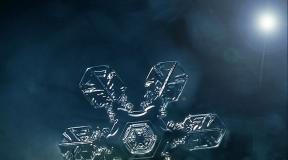Why there are no identical snowflakes. Question of the day: how snowflakes are formed and why there are no two identical "Land of Snows" - such a poetic name was invented for Tibet by its inhabitants
The site for schoolchildren and their parents, Zateevo.ru, found out that there are no identical snowflakes!
S N E G I N K I
ON THE
PHOTOS BY YAROSLAV HNATYUK!
There is nothing more weightless than tiny snowflakes. Will fall on your hand, you won't feel it!

They weigh about a milligram, rarely 2 ... 3 milligrams.

People rarely look at snowflakes, and you can't find two completely identical snowflakes. In the best collections of micrographs, there are more than 5 thousand images of snowflakes that are different from each other.

ZATEEVO presents a collection of snowflakes by the Ukrainian photographer Yaroslav Yurievich Hnatyuk. Yaroslav Hnatyuk lives and works in Dnepropetrovsk, his work is related to banking payment systems, and photomicrography is a hobby. But his photographs are so professional that this year he became the winner of the Yandex photo contest.

Why are all snowflakes so different?
At first, all the buds of snowflakes look like tiny hexagonal prisms. Then, from the six corners of the prism, absolutely identical ice needles - lateral processes - begin to grow. The same needles because the temperature and humidity around the embryo are also the same. On them, in turn, grow, as on a tree, lateral processes - twigs. The snowflake begins to grow rapidly in size. In this case, the bulging areas of the snowflake grow faster. So, from the originally hexagonal plate, a six-rayed asterisk grows. Moving up and down in the cloud, the snowflake gets into conditions with different temperatures and water vapor content. Its shape is changing. This is how the snowflakes become different. Although in the same cloud at the same height, they can "originate" the same. Each snowflake has its own path to the ground. This means that each has its own final form. Snowflakes fall at a speed of about 15 meters per minute. They are almost unconnected, and even a small wind of 2 meters per second sets them in motion. In the air, the shape of the snowflakes is constantly changing. Many factors affect the formation and growth of snowflakes.

The ice that forms the snowflake is transparent. But when there are many snowflakes, the sunlight, reflecting and scattering on the numerous faces of the snowflakes, gives us the impression of a white opaque mass - we call it snow. Colliding on its way with supercooled small droplets of water, the snowflake is simplified in shape. When faced with a large drop, it can turn into a hailstone. In different places "own" snow falls, depending on weather conditions.

It is known that in the spring of 1944 snow flakes of up to 10 centimeters in size fell in Moscow. Snow flakes up to 30 centimeters were observed in Siberia. A necessary condition for this is complete calmness. Snowflakes whirl in the air for a long time, rising and falling, traveling for a long time, colliding and grappling with each other. The slightest breeze breaks such flakes into separate pieces. In low temperatures and strong winds, snowflakes collide in the air, crumble and fall to the ground in the form of debris.













All materials of the children's site Zateevo.ru are collected here:. The site for children Zateevo.ru is the only educational resource of this kind among those that can be found in the catalogs of children's sites. Zateevo.ru changes the usual view of the school Internet!
The statement, familiar to every schoolchild, that there are no two identical snowflakes, was repeatedly questioned. But the unique research of the California Institute of Technology was able to put the final point on this truly New Year's question.
Snow forms when microscopic water droplets in clouds are attracted to dust particles and freeze.
Ice crystals appearing at the same time, not exceeding at first 0.1 mm in diameter, fall down and grow as a result of moisture condensation from the air on them. In this case, six-pointed crystalline forms are formed.
Due to the structure of water molecules, angles of only 60 ° and 120 ° are possible between the beams of the crystal. The main water crystal has the shape of a regular hexagon in the plane. On the tops of such a hexagon, new crystals are then deposited, on them - new ones, and this is how various forms of snowflake stars are obtained.
University of California physics professor Kenneth Libbrecht has unveiled the results of many years of research by his research group. "If you see two identical snowflakes, they are still different!" - says the professor.
Libbrecht proved that in the composition of snow molecules for about every five hundred oxygen atoms with a mass of 16 g / mol, there is one atom with a mass of 18 g / mol.
The structure of the bonds of a molecule with such an atom is such that it assumes an infinite number of variants of compounds within the crystal lattice.
In other words - if two snowflakes really look the same, then their identity still needs to be checked at the microscopic level.
Studying the properties of snow (and, in particular, snowflakes) is not child's play. Knowledge about the nature of snow and snow clouds is very important when studying climate change.
The same snowflakes occur in nature. In exceptional cases. This was first recorded by specialists from the US National Center for Atmospheric Research in 1988.
Photo: pixabay.com
Researcher Nancy Knight in his work "No Two Alike?" proved that identical snowflakes can occur in nature.
Knight came to this conclusion after she experimentally obtained the same snowflakes in the laboratory. She proved her theory mathematically, through the theory of probability. She deduced 100 distinctive features of snowflakes, by which it can be judged that there are 10 to 158 degrees of different variants of snowflakes. And while the resulting number is infinitely large, that doesn't rule out the possibility of snowflakes coinciding, Knight argues.
At the same time, according to the statement Professor of Physics at the University of California, Kenneth Libbrecht, outwardly identical snowflakes have differences in the internal structure, namely, in the crystal lattice. Therefore, it cannot be said that, in principle, it is possible to find completely identical snowflakes in shape and in atomic structure.
How are snowflakes formed and why are they different in shape?
The process of snowflake formation includes the sublimation of crystals from the gas phase, bypassing the liquid state. When a snowflake is formed, water molecules grow chaotically from the moment the initial crystal is formed. Thus, the snowflake grows in a disordered manner.
The growth of snowflakes depends on external conditions such as temperature and humidity. Depending on these and other conditions, new layers of molecules are superimposed on each other, each time forming a new shape of a snowflake.
All snowflakes have six faces, because when they freeze, water molecules line up in a special order, as a result of which a hexagonal geometric figure is formed.
The growth of a snowflake is due to the air temperature at which it was formed. The lower the temperature was, the smaller the size of the snowflake will be.
The direction of growth of the snowflake is due to the fact that the ice crystals are hexagonal. Two crystals cannot be connected by an angle, they always join each other by a face. Therefore, the rays always grow in six directions, and the "branch" can depart from the ray only at an angle of 60 or 120 degrees.
Have you ever heard the phrase "this snowflake is special", they say, because there are usually a lot of them and they are all beautiful, unique and fascinating if you look closely. Old wisdom says that no two snowflakes are alike, but is that really true? How can you even say this without looking at all the falling and falling snowflakes? Suddenly a snowflake somewhere in Moscow is no different from a snowflake somewhere in the Alps.
To consider this question scientifically, we need to know how a snowflake is born and what the probability (or improbability) is that two of the same will be born.

Snowflake taken with a conventional optical microscope
A snowflake, in essence, is just water molecules that bind together in a certain solid configuration. Most of these configurations have some sort of hexagonal symmetry; this has to do with how water molecules, with their specific bond angles - which are determined by the physics of an oxygen atom, two hydrogen atoms, and electromagnetic force - can bond together. The simplest microscopic snow crystal that can be viewed under a microscope is one millionth of a meter (1 micron) in size and can be very simple in shape, for example, a hexagonal crystal plate. Its width is about 10,000 atoms, and there are a lot of similar ones.

According to the Guinness Book of World Records, Nancy Knight of the National Center for Atmospheric Research, by sheer luck, discovered two identical snowflakes while studying snow crystals during a blizzard in Wisconsin, taking a microscope with her. But when representatives certify two snowflakes as identical, they can only imply that the snowflakes are identical for microscope accuracy; when physics requires two things to be identical, they must be identical to within a subatomic particle. This means:
- you need the same particles,
- in the same configurations,
- with the same connections
- in two completely different macroscopic systems.
Let's see how this can be arranged.

One water molecule is one oxygen atom and two hydrogen atoms bonded together. When frozen water molecules bind to each other, each molecule gets nearby four other bound molecules: one at each of the tetrahedral vertices above each individual molecule. This leads to the fact that water molecules are folded into a lattice shape: a hexagonal (or hexagonal) crystal lattice. But large "cubes" of ice, as in quartz deposits, are extremely rare. When you look at the smallest scales and configurations, you find that the top and bottom planes of this lattice are packed and connected very tightly: you have “flat edges” on two sides. The molecules on the remaining sides are more open, and additional water molecules bind to them more randomly. In particular, hexahedral corners have the weakest bonds, so we observe sixfold symmetry in crystal growth.

and the growth of a snowflake, a particular configuration of an ice crystal
New structures then grow in the same symmetrical patterns, increasing hexagonal asymmetries when they reach a certain size. Large, complex snow crystals contain hundreds of easily distinguishable features when viewed under a microscope. Hundreds of features among the roughly 10 19 water molecules that make up a typical snowflake, according to Charles Knight of the National Center for Atmospheric Research. For each of these functions, there are millions of possible places where new branches can form. How many such new features can a snowflake form without becoming one of many?
Every year around the world, approximately 10 15 (quadrillion) cubic meters of snow falls to the ground, and each cubic meter contains on the order of several billion (10 9) individual snowflakes. Since the Earth has existed for about 4.5 billion years, 10 34 snowflakes have fallen on the planet throughout history. And do you know how many, in terms of statistics, separate, unique, symmetrical branching features could a snowflake have and expect a double at a certain moment in the history of the Earth? Only five. Whereas real, large, natural snowflakes usually have hundreds of them.

Even at the level of one millimeter in a snowflake, you can see imperfections that are difficult to duplicate.
And only at the most mundane level can you mistakenly see two identical snowflakes. And if you're ready to go down to the molecular level, things get much worse. Usually oxygen has 8 protons and 8 neutrons, and hydrogen has 1 proton and 0 neutrons. But 1 out of 500 oxygen atoms has 10 neutrons, 1 out of 5,000 hydrogen atoms has 1 neutron, not 0. Even if you form perfect hexagonal snow crystals, and in the entire history of planet Earth you have counted 10 34 snow crystals, it will be enough to descend to the size several thousand molecules (less than the length of visible light) to find a unique structure that the planet has never seen before.

But if you ignore the atomic and molecular differences and abandon the "natural", you have a chance. Snowflake researcher Kenneth Libbrecht of the California Institute of Technology has developed a technique to create artificial "identical twins" of snowflakes and photograph them using a special microscope called the SnowMaster 9000.
By growing them side by side in the laboratory, he showed that it is possible to create two snowflakes that are indistinguishable.

Two nearly identical snowflakes grown in the Caltech lab
Almost. They will be indistinguishable to a person who looks with their own eyes through a microscope, but they will not be identical in truth. Like identical twins, they will have many differences: they will have different binding sites of molecules, different branching properties, and the larger they are, the stronger these differences. This is why these snowflakes are very small and the microscope is powerful: they are more similar when less complex.

Two nearly identical snowflakes grown in a laboratory at Caltech
Nevertheless, many snowflakes are similar to one another. But if you are looking for truly identical snowflakes at a structural, molecular or atomic level, nature will never give you this. This number of possibilities is great not only for the history of the Earth, but also for the history of the Universe. If you want to know how many planets you need to get two identical snowflakes in 13.8 billion years of the history of the Universe, the answer is about 10 100000000000000000000000. Given that there are only 10 80 atoms in the observable universe, this is highly unlikely. So yes, snowflakes are really unique. And that's to put it mildly.
The young farmer Wilson Alison Bentley, nicknamed "Snowflake", pioneered the study of the "theory of snow". From childhood, he was attracted by the unusual shape of crystals falling from the sky. In his hometown of Jericho, in the northern United States, snowfall was a regular occurrence, and young Wilson spent a lot of time outside studying snowflakes.
Whislon "Snowflakes" Bentley
Bentley adapted a camera to the microscope donated by his mother for the 15th birthday and tried to capture the snowflakes. But it took almost five years to improve the technology - only on January 15, 1885 the first clear picture was received.
Throughout his life, Wilson captured 5000 different snowflakes in photographs. He never ceased to admire the beauty of these miniature works of nature. To obtain his masterpieces, Bentley worked in sub-zero temperatures, placing each whole snowflake he found on a black background.
Wilson's work has been highly regarded by scholars and artists alike. He was often invited to speak at scientific conferences or exhibit photographs in art galleries. Unfortunately, Bentley died at the age of 65 from pneumonia, without proving that there are no identical snowflakes.
A hundred years later, Nancy Knight, a researcher at the National Center for Atmospheric Research, took up the baton of "snow theory". In a paper published in 1988, she proved the opposite - the same snowflakes can and should exist!

Dr. Knight tried to replicate the process of building snowflakes in a laboratory setting. To do this, she grew several water crystals, subjecting them to the same processes of hypothermia and supersaturation. As a result of the experiments, she managed to get snowflakes absolutely identical to each other.
Further field observations and processing of experimental errors allowed Nancy Knight to assert that the appearance of identical snowflakes is possible and is determined only by the theory of probability. After compiling a comparative catalog of celestial crystals, Knight concluded that there are 100 signs of difference in snowflakes. Thus, the total number of appearance options is 100! those. almost 10 to the 158th power.
The resulting number is twice as many as the number of atoms in the universe! But this does not mean that coincidences are completely impossible - Dr. Knight concludes in his work.
And now - new research on the "theory of snow". The other day, professor of physics at the University of California, Kenneth Libbrecht, published the results of many years of research by his scientific group. "If you see two identical snowflakes, they are still different!" - says the professor.
Libbrecht proved that in the composition of snow molecules for about every five hundred oxygen atoms with a mass of 16 g / mol, there is one atom with a mass of 18 g / mol. The structure of the bonds of a molecule with such an atom is such that it assumes an infinite number of variants of compounds within the crystal lattice. In other words - if two snowflakes really look the same, then their identity still needs to be checked at the microscopic level.
Studying the properties of snow (and, in particular, snowflakes) is not child's play. Knowledge about the nature of snow and snow clouds is very important when studying climate change. And some of the unusual and unexplored properties of ice have practical applications.



















